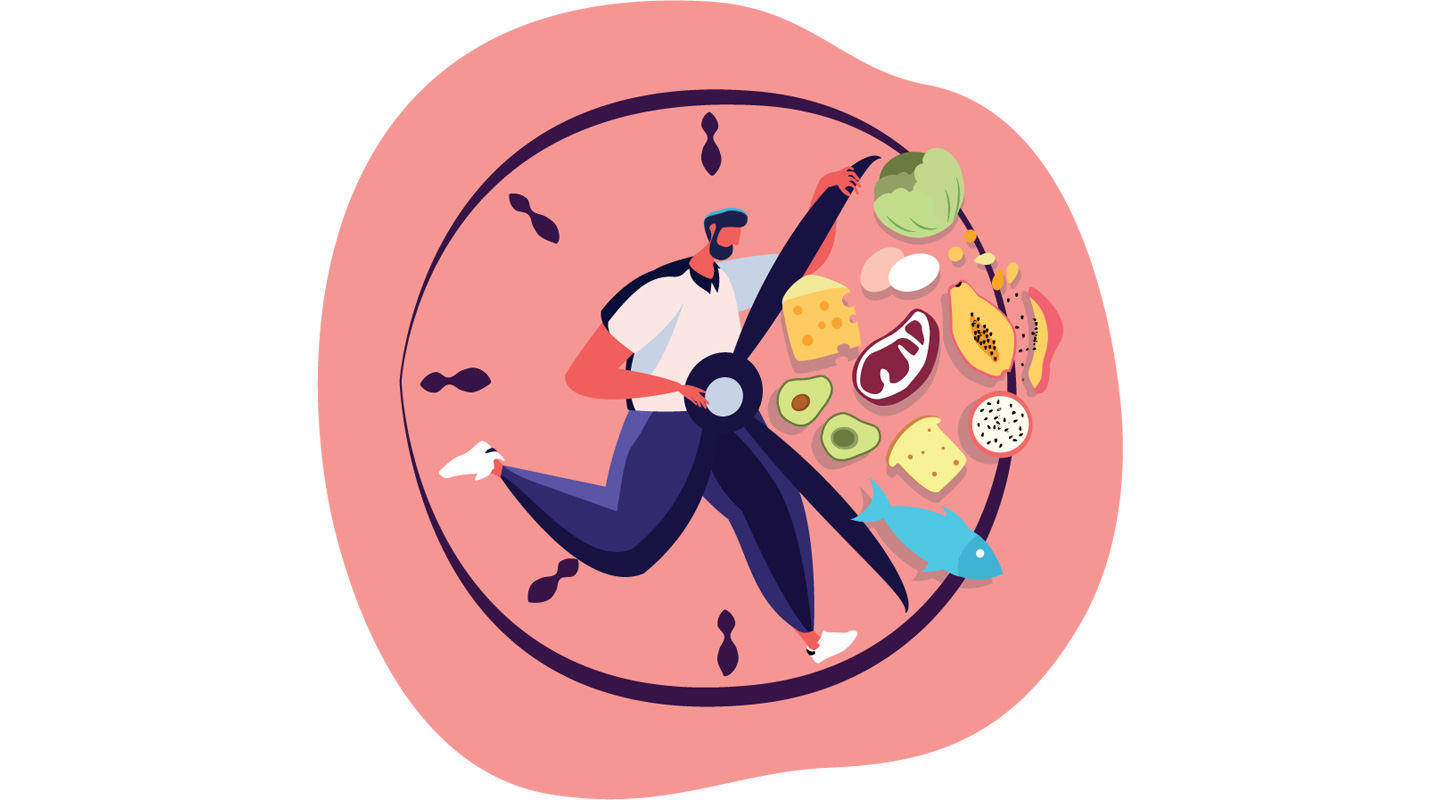敬告讀者: 《中大通訊》已停刊,本網暫停更新。請移玉步造訪本校最新通訊《走進中大》網頁:https://focus.cuhk.edu.hk,閱讀大學報道和消息。
不時不食

I have not eaten in over 17 hours.
My stomach isn’t growling; I am not hungry. I only hear the clacking of my keyboard. Words fall from my fingertips quickly and with precision. I feel alert and focused. My colleagues invited me to lunch though I declined, instead opting to continue drinking the coffee beside me—ink-black, devoid of milk and sugar—to keep my caloric intake at zero. Each day, I have my first calories at 2:00 pm and my last calories just before 8:00 pm, giving me a six-hour eating window. Besides coffee and tea, I abstain from food and drink for 18 hours per day. And no—I am not doing this to punish myself.
This is intermittent fasting, or time-restricted eating. Calling this a ‘diet’ is a misnomer. I’m far too fond of chocolate chip cookies to adhere to a diet. Intermittent fasting is less about what you eat and more about when you eat. You eat as you normally would, but within certain time parameters.
Advocacy for intermittent fasting from high-profile celebrities like Beyoncé, Hugh Jackman and others have helped intermittent fasting gain traction. Forbes included it on their list of 2018’s trendiest health choices. Notwithstanding star-studded practitioners, intermittent fasting is merely being popularized, not discovered. It isn’t a new idea. This habit has been a mainstay in various religious practices since the dawn of civilization. In Buddhism, certain practices required monks to fast after lunch until the following morning and, similarly, abstaining from food during ‘daylight hours’ is noted in the Old Testament.
Science backs the Buddha and Jesus. In 2018, an article published in Cell Metabolism found evidence of improved insulin levels, blood pressure, and weight-loss for a group of subjects participating in time-restricted eating. A paper in PubMed posited that this method can reduce inflammation and slow cell aging (cellular senescence). Both studies changed little about what was consumed—the focal variable was when.
The word ‘fasting’ inspires fear in many, and any notion of dieting usually sends crowds to the exits. But intermittent fasting is more lifestyle-friendly than you may presume. The most popular method, 16/8, includes a 16-hour fast and eight-hour eating window. For example, if you stop eating at 8:30 pm you would have lunch at the very regular hour of 12:30 pm the following afternoon. Simply put, this entails skipping breakfast and eliminating late-night snacking.
I have been intermittent fasting for some years now, since my days in university. As a student, it helped streamline my fitness, mental clarity, and productivity—pillars of success for the university lifestyle. I would go about my morning lectures and assignments without giving a thought to food. It fitted into my lifestyle and simplified my routine. I didn’t have to focus on chopping, boiling, microwaving, or scrambling anything for the first half of my day, resulting in more energy for my studies. My roomates adopted the lifestyle too. Together, we happily avoided the breakfast rush in the school cafeteria and instead had more time to prepare for classes (or more time to recover from the antics of the previous night).
Fasting has remained a convenience during my time as a CUHK staff member: I still hold the luxury of avoiding the morning breakfast rush, and even my sleep schedule benefits—I never sneak around my kitchen late at night to quell cravings and I can sleep in without worrying about eating before work.
Intermittent fasting, for myself, has been a valuable practice in mindfulness. It teaches self-discipline, short-term sacrifice for long-term benefits, and gratitude. I’ve learned to only eat until satiated, rather than gorging myself in a fit of boredom, or only because the television is on. I appreciate my meals and avoid eating for the sake of eating—something that plagues us more often than we may admit.
A shorter, 12-hour fast is a viable starting point to ease into intermittent fasting before increasing to a 14- or 16-hour fast. It can help to try one or two days per week at first to determine efficacy and personal fit.
Like all new habits, intermittent fasting should be implemented gradually, with prudence, and in concert with your lifestyle. This shouldn’t take on the role of tyrant—find a balance and personalize the parameters to your schedule. Don’t slow your progress—go fast.
Phil Rosen
本文出自《中大通訊》第549/550期(2020年1月)